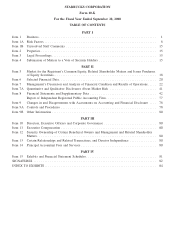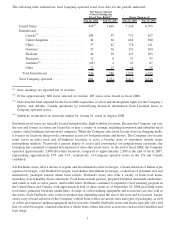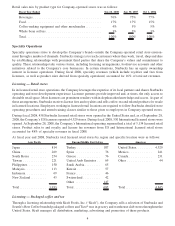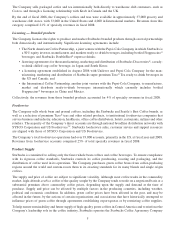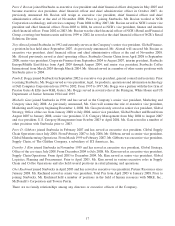Starbucks 2008 Annual Report Download - page 16
Download and view the complete annual report
Please find page 16 of the 2008 Starbucks annual report below. You can navigate through the pages in the report by either clicking on the pages listed below, or by using the keyword search tool below to find specific information within the annual report.• information technology costs and other logistical resources necessary to maintain and support the global
growth of the Company’s business; and
• delays in store openings for reasons beyond the Company’s control, or a lack of desirable real estate
locations available for lease at reasonable rates, either of which could keep the Company from meeting
annual store opening targets and, in turn, negatively impact net revenues, operating income and earnings per
share;
• any material interruption in the Company’s supply chain beyond its control, such as material interruption of
roasted coffee supply due to the casualty loss of any of the Company’s roasting plants or the failures of third-
party suppliers, or interruptions in service by common carriers that ship goods within the Company’s
distribution channels; and
• the impact on Starbucks business of factors such as labor discord, war, terrorism (including incidents
targeting Starbucks), political instability in certain markets and natural disasters.
•The global economic crisis could adversely affect the Company’s business and financial results and have
a material adverse affect on Starbucks liquidity and capital resources.
As the recent global financial crisis has broadened and intensified, other sectors of the economy have been
adversely impacted and a severe global recession now appears likely. As a retailer that is dependent upon consumer
discretionary spending, the Company will face an extremely challenging fiscal 2009 because Starbucks customers
may have less money for discretionary purchases as a result of job losses, foreclosures, bankruptcies, reduced access
to credit and sharply falling home prices. Any resulting decreases in customer traffic or average value per
transaction will negatively impact the Company’s financial performance as reduced revenues result in sales de-
leveraging which creates downward pressure on margins. Additionally, many of the effects and consequences of the
global financial crisis and a broader global economic downturn are currently unknown; any one or all of them could
potentially have a material adverse effect on the Company’s liquidity and capital resources, including Starbucks
ability to issue commercial paper and to raise additional capital if needed, the ability of banks to honor draws on
Starbucks credit facility, or otherwise negatively impact the Company’s business and financial results.
•Starbucks is highly dependent on the financial performance of its United States operating segment.
The Company’s financial performance is highly dependent on its United States operating segment, which
comprised 76% of consolidated total net revenues in fiscal 2008. The Company experienced a substantial
down-turn in traffic in its US stores in fiscal 2008, which adversely affected the operating results of the US
segment and the Company as a whole. If the US segment is unable to improve its financial performance, the
Company’s business and financial results will continue to be adversely affected.
•Starbucks may not fully realize the anticipated positive impacts to future financial results from the
restructuring measures announced in July 2008.
In July 2008, the Company announced several restructuring measures as part of the Company’s multi-faceted plan
to transform its business and improve results of operations, including a plan to close approximately 600 under-
performing Company-operated stores in the US market, a restructuring of the Australia market, and certain
leadership and non-store organization changes. There can be no assurance that the Company will fully realize the
anticipated positive impacts to future financial results from these restructuring measures. The estimated costs and
charges associated with the US store closures are based on management’s assumptions and projections and may
vary materially based on various factors, including the timing of store closures, the outcome of negotiations with
landlords and other third parties, the Company’s ability to place affected partners (employees) into available
positions at other Starbucks stores, and other changes in management’s assumptions and projections. As a result of
these events and circumstances, delays and unexpected costs may occur, which could result in the Company not
fully realizing the anticipated positive impact to the Company’s future financial results from such US store closures.
Further, to the extent that the Company is unable to improve its financial performance in fiscal 2009, further
restructuring measures may be required in the future.
10


